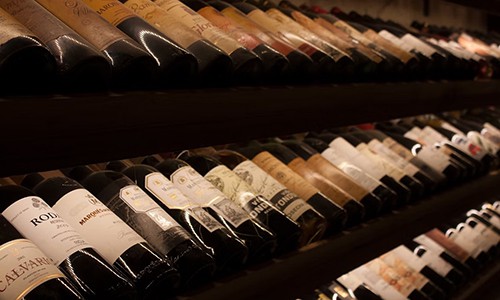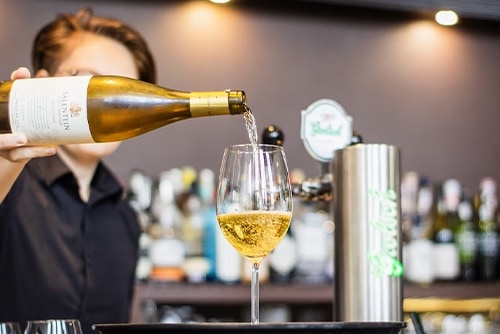The 20 Most Unique Restaurant Ideas Around The World
Dining, at its heart, is all about the food. But there are only so many ways to ...

If your restaurant offers bring-your-own-beer (BYOB) or bring-your-own-wine (BYOW) service, you may want to charge a corkage fee. What does that entail? Why would you do it in the first place, and what would you charge?
In this article, we’ll answer those questions to help you decide whether a corkage fee is right for your business.

At its most basic, a corkage fee (or just “corkage” for short) is the amount a restaurant might charge a diner if they were to bring their own bottle of alcohol — typically wine — into the establishment to consume during the meal.
Seems simple enough, right? But let’s back up a bit and examine the details of these carry-in policies so you understand what it means to charge a corkage fee.
A restaurant might institute bring-your-own-beer (BYOB) or bring-your-own-wine (BYOW) policies for any number of reasons (some of which we’ll discuss in the next section).
But just because guests can carry in their own alcohol doesn’t mean the restaurant will charge a corkage fee.
If a restaurant is BYOB, they’ll allow you to carry in your own adult beverage — they’ll even open it and pour it for you — and won’t charge you for it.
If BYOW, the restaurant will allow you to carry in your own adult beverage — again, providing opening and pouring service — but they’ll charge you a few dollars for the server’s time and effort.
Though it may seem similar, this latter case is not a real corkage fee. For that, we have to look at a different case.
A true corkage fee is a term used exclusively by bars and restaurants that adhere to the established steps of properly serving the beverage (typically wine), including, but not limited to:
In a bar or restaurant with true corkage, there is much more involved in handling the beverage than just opening the bottle and setting it on the table. That’s why some establishments charge 10 times or more what another restaurant would charge for the basic BYOB or BYOW service.

If your restaurant doesn’t serve alcohol (and doesn’t intend to) or doesn’t serve alcohol yet, you might consider implementing a BYOW policy.
In any of those cases, you could charge anywhere from $5 to $50 or more depending on the level of service you offer. We’ll discuss what to charge for corkage later on in this article.
Be sure to check your local regulations to make sure you have everything you need if you plan to allow alcohol in your restaurant.
Imagine this: You and your partner are celebrating your anniversary at your favorite local restaurant and want to mark the occasion by sharing a bottle of that delightful Riesling Auslese you found on your cruise down the Rhine all those years ago.
Unfortunately, the restaurant or bar doesn’t offer that variety of wine. You’ll either have to go somewhere that does offer the wine (you’ve already checked and none in your area do) or settle for another variety.
But what if you could bring a bottle from your private collection and enjoy it with your favorite food? What an experience that would be!
This situation illustrates another reason why your restaurant might want to charge a corkage fee. Allowing patrons to carry in their favorite wine — perhaps one you don’t offer — is a great way to keep people coming back.
A lot goes into the proper wine service, and your restaurant is proud of what it has to offer.
Whether you allow BYOW or not, your wine service involves:
As you can see, this service is more than just simply pouring glasses at the table. And it needs to be done right to be effective.
If your restaurant goes to these lengths to provide the best dining experience, it’s worth charging for.

In most cases, when diners order wine — or bring it in themselves — they’ll spend more time at the table than diners who don’t order wine.
Long turnover times can seriously affect the low margins under which your restaurant is already operating. A corkage fee helps control turnover time by preventing patrons from bringing in a cheap bottle just so they can occupy the table longer.
No one wants to spend $40 for corkage on a $10 bottle of wine for the privilege of sitting in your restaurant for 10 or 20 extra minutes.
Beverage costs help keep your bar or restaurant in the black, and a BYOB or BYOW policy can cut into those profits.
Charging a fee for the service you offer on carry-in wine helps your business recoup the loss you’ll see on your receipts.
Building a wine program is generally not a cheap endeavor. In many cases, it requires that your restaurant:
Charging a corkage fee makes it possible to allow wine enthusiasts to bring their own bottle, while, at the same time, allowing your restaurant to put money aside to build or maintain its wine program.

The average corkage fee falls somewhere between $10 and $40 and depends, in large part, on the state in which your restaurant operates.
Here are several examples from major cities:
If you want to encourage patrons to bring their own bottle, set a price on the lower end of the scale. But if you want to discourage patrons from bringing their own bottle, set a price on the higher end of the scale.
This latter option — charging a $100 corkage fee, for example — would make it extremely clear that your restaurant would prefer that guests choose a beverage from the in-house wine list.
Before you decide to implement a corkage fee — or even a BYOB or BYOW policy — be sure to consult an attorney who is familiar with the restaurant industry in your area and the liquor laws that apply to it.
Do your research and make sure any policies you enact for your bar or restaurant are legal.

A big part of making your corkage fee successful is first establishing policies that benefit your restaurant and then training diners to understand how those policies apply to them.
Above all, you want your customers to know that corkage fee and BYOB is about dining with a special bottle that is old, rare, or has emotional value (and that you don’t carry) — not about them paying less for beverages.
Here are some things you can do to make implementing a corkage fee as easy as possible for your customers.
Ultimately, you don’t want diners walking in off the street with a six-pack of Budweiser they picked up at the bodega around the corner. That’s not good for your business.
To prevent this from happening, encourage your patrons to call first to find out what the corkage fee policies are.
Repeat customers will likely get the hang of it after their first visit, but you’ll need some way to get first-time customers to call before they carry in.
Consider including a “Please call about our BYOB policies” message in all your advertising. You may also want to post an attractive sign outside your restaurant where passersby can see it. This is especially effective if you display your daily menu outside to draw in customers.
Another very effective way to make the corkage fee easy for your customers is to train your staff to mention the policies in every interaction they have with potential diners.
All employees — from the newest hires to the long-time team members — should be ready and able to pass on information about the BYOW program regardless of the original topic of conversation.
This may include times when customers call for reservations, have questions about the menu, or simply walk in off the street.
You can get the ball rolling by preparing your staff with a simple question — “Oh, have you heard about our BYOW program?” — that can help them broach the subject in any conversation.
The more your staff mentions the corkage fee at your restaurant, the less likelihood that there will be confusion among your clientele.
You may also want to consider establishing limits on the number of bottles a diner may carry in with them.
For example, you may allow one bottle of wine for every four people in the party. Thus, a party of eight would be allowed to bring two bottles of their favorite beverage. If they would like more than those two bottles, they can purchase another from your beverage list.
You may even want to cap the total number of bottles that a single group can carry in so that you don’t have a party of twenty bringing an entire case of wine.
Just to reiterate, in most cases, one or two bottles may make sense, but bringing a case of wine or beer — even for a large group — may be beyond the pale.
If you do establish limits on the number of bottles a customer may carry in, be sure to mention it whenever you and your staff talk about the corkage fee policy.
Make it clear that customers should not carry in a wine or beer that is already on your beverage list.
Remember, the whole concept of BYOW or BYOB isn’t about customers paying less for what they drink, but about adding something special to the dining experience.
So, for example, if your wine list already includes a 2010 Dr. Pauly Bergweiler Bernkasteler Badstube Riesling Spätlese and they want to carry in the exact same bottle, you may not want to allow that.
At the same time, you may need to be sensitive to small details such as the year of the vintage they want to bring.
For example, if a couple wants to bring a bottle of the 2008 Dr. Pauly Bergweiler Bernkasteler Badstube Riesling Spätlese because it’s the year they got married, it’s the year their child was born, or it marks some other special occasion, you may choose to permit it.
Whatever criterion you come up with, communicate the “no overlap” policy to anyone and everyone who might be a potential customer.
You may also want to consider providing a printed copy of your beverage list and corkage fee policies so that customers have something to refer to before they arrive.
Avoiding overlap can help you maintain your bottom line while ensuring that your customers enjoy the experience of dining at your restaurant.

It’s also a good idea to advise customers to look at the menu before deciding they want to bring their own bottle.
Food usually dictates the wine, not the other way around, so customers might not enjoy the dining experience as much as they could if they allow you to suggest a wine that goes with their meal.
For example, they may choose to bring in a bold red wine to pair with your signature chicken dish. In most cases, red wine goes better with beef, while white wine complements chicken and fish.
They may not be aware of this fact, so advising them to examine the menu first can help you help them have the best experience possible.
To avoid customers bringing in “cheap” wine or beverages in an attempt to get out of paying your restaurant’s higher prices, you may want to set a minimum dollar amount threshold.
For example, you may set your corkage fee at $15 and not allow bottles of wine or beer below that price.
If you choose to go this route, some restaurants have found success with setting their corkage fee at the same level as their cheapest wine. That way, your restaurant will be sure to make money regardless of what the customer chooses to do.
A good sommelier or beverage manager should always be on the lookout for a new wine or beer to add to the restaurant’s list.
You may choose to allow customers to share a sip or two with those individuals on your staff as a sign of respect and camaraderie. Your beverage managers may not accept, but the simple act of offering can go a long way toward making the dining experience all the better.
Offering the sommelier a sip of a rare, old, or expensive wine is the perfect way to get in their good graces, and they may choose to waive the corkage fee as a way to show their appreciation.
Welcome sharing, and communicate this fact to everyone who asks about your corkage fee policy.
Another way to make the corkage fee and the privilege of carrying in their own beverage good for both your restaurant and the customer is to discourage lingering.
To do so, you may need to establish a policy that any beverages the customer carries in must be consumed before or during their meal.
A policy like this prevents customers from uncorking a bottle of wine after the dishes have been cleared. Such behavior prevents the front-of-house staff from turning over the table so that another party can be seated.
Of course, you’ll want to make it clear that if a party wants to linger after the meal with a bottle of wine purchased from your cellar, they are welcome to do so.
If you implement a corkage fee in your restaurant, be sure to give your guests all of the information they need upfront so the dining experience is as enjoyable as possible.
Providing as much information as possible before the diners arrive helps them take responsibility for their meal and may eliminate the speedbumps that can get in the way of a delightful experience.

Whether you choose to charge a corkage fee or not, your bar or restaurant can benefit from a robust workforce management (WFM) program. For true, 21st-century WFM, implement the Sling suite of tools in your workflow.
The sole purpose of Sling is to streamline and simplify every aspect of your workforce management so that your entire team can work smoothly and efficiently, and you can have more time to make your business run better.
You, your team, and your business can accomplish so much when you use one integrated tool, like Sling, for all your workforce management activities.
For more free resources to help you improve the way your business operates, organize and schedule your workforce, and track and calculate labor costs, visit GetSling.com today.
See Here For Last Updated Dates: Link
This content is for informational purposes and is not intended as legal, tax, HR, or any other professional advice. Please contact an attorney or other professional for specific advice.
Schedule faster, communicate better, get things done.